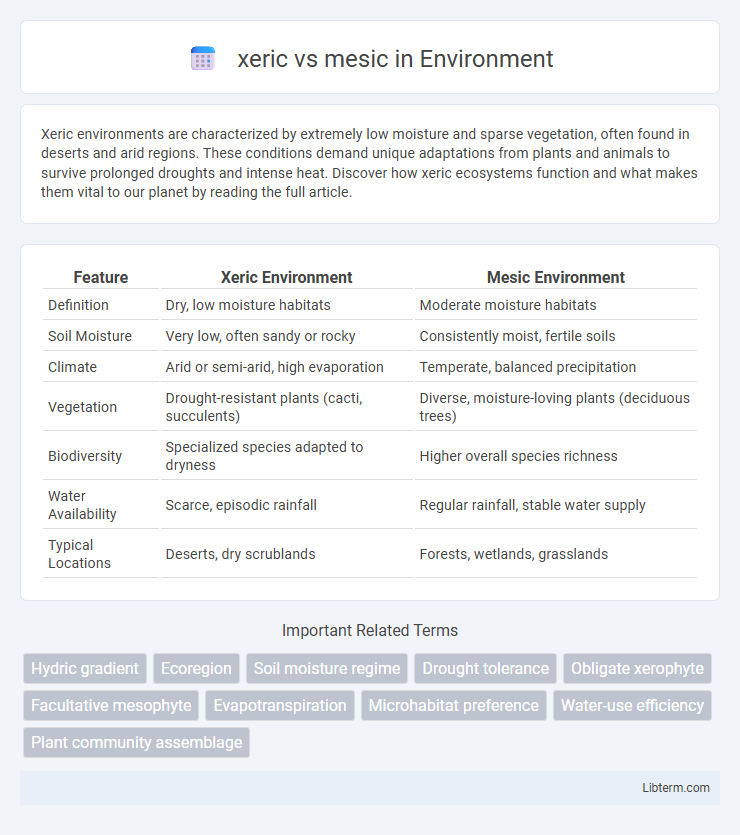Xeric environments are characterized by extremely low moisture and sparse vegetation, often found in deserts and arid regions. These conditions demand unique adaptations from plants and animals to survive prolonged droughts and intense heat. Discover how xeric ecosystems function and what makes them vital to our planet by reading the full article.
Table of Comparison
| Feature | Xeric Environment | Mesic Environment |
|---|---|---|
| Definition | Dry, low moisture habitats | Moderate moisture habitats |
| Soil Moisture | Very low, often sandy or rocky | Consistently moist, fertile soils |
| Climate | Arid or semi-arid, high evaporation | Temperate, balanced precipitation |
| Vegetation | Drought-resistant plants (cacti, succulents) | Diverse, moisture-loving plants (deciduous trees) |
| Biodiversity | Specialized species adapted to dryness | Higher overall species richness |
| Water Availability | Scarce, episodic rainfall | Regular rainfall, stable water supply |
| Typical Locations | Deserts, dry scrublands | Forests, wetlands, grasslands |
Defining Xeric and Mesic Environments
Xeric environments are characterized by low moisture availability, often found in deserts and arid regions where drought-resistant vegetation dominates. Mesic environments maintain moderate moisture levels, supporting diverse plant and animal life typical of temperate forests and grasslands. Understanding these conditions is crucial for ecological research, conservation, and habitat management.
Key Differences Between Xeric and Mesic Habitats
Xeric habitats are characterized by dry, arid conditions with minimal water availability, supporting drought-tolerant flora such as cacti and succulents. In contrast, mesic habitats have moderate moisture levels, fostering diverse plant communities including deciduous forests and grasslands. Soil composition also differs significantly, with xeric environments featuring sandy, well-drained soils, while mesic areas contain richer, moisture-retentive substrates.
Climate Characteristics of Xeric vs. Mesic Regions
Xeric regions exhibit arid to semi-arid climates characterized by low annual precipitation, high evaporation rates, and significant temperature fluctuations between day and night. Mesic regions experience moderate to high precipitation with relatively stable humidity levels and milder temperature ranges, supporting dense vegetation and diverse ecosystems. The soil moisture in xeric areas remains consistently low, while mesic environments maintain soil moisture conducive to robust plant growth.
Soil Properties in Xeric and Mesic Ecosystems
Xeric soils are typically sandy or rocky with low organic matter, resulting in poor water retention and high drainage rates, which create dry conditions crucial for drought-tolerant plant species. Mesic soils contain higher organic content and finer textures like loam or clay, enhancing moisture retention and nutrient availability that support diverse and lush vegetation. Soil pH in xeric environments often trends more alkaline due to limited leaching, whereas mesic soils generally have more neutral to slightly acidic pH levels influenced by consistent moisture.
Plant Adaptations in Xeric and Mesic Zones
Plants in xeric zones exhibit adaptations such as thick cuticles, reduced leaf surface area, and deep root systems to conserve water in arid environments. In contrast, mesic zone plants typically have broader leaves, thinner cuticles, and shallower roots to maximize water uptake and photosynthesis in more moderate moisture conditions. These differences in morphological and physiological traits reflect evolutionary responses to varying water availability across xeric and mesic habitats.
Animal Life and Survival Strategies
Xeric environments, characterized by low moisture, support animal species with adaptations such as water-conserving behaviors, nocturnal activity, and specialized kidneys to minimize water loss. In contrast, mesic habitats provide moderate moisture levels, enabling a diverse range of animals to thrive with fewer extreme water retention adaptations, often supporting species with higher reproductive rates and broader foraging behaviors. Survival strategies in xeric zones emphasize drought resistance and resource efficiency, while mesic animals leverage habitat stability for competitive feeding and breeding advantages.
Distribution and Examples of Xeric and Mesic Habitats
Xeric habitats, characterized by low moisture levels, are commonly found in arid regions such as deserts of the southwestern United States and parts of Australia, hosting species like cacti and sagebrush. Mesic habitats, with moderate moisture availability, occur in temperate forests of the eastern United States and parts of Europe, supporting diverse vegetation such as oaks, maples, and ferns. The distribution of xeric and mesic environments is strongly influenced by regional climate patterns and soil moisture retention capabilities.
Ecological Importance of Xeric and Mesic Systems
Xeric systems, characterized by low moisture availability, support specialized drought-resistant species that play a critical role in nutrient cycling and soil stabilization in arid environments. Mesic systems, with moderate moisture levels, foster rich biodiversity and provide essential habitats for a wide range of flora and fauna, contributing to ecosystem resilience and carbon sequestration. Both xeric and mesic ecosystems are vital for maintaining ecological balance, supporting wildlife populations, and sustaining ecosystem services such as water filtration and climate regulation.
Human Impact on Xeric and Mesic Environments
Human activities significantly alter xeric and mesic environments, with urbanization and agriculture intensifying water scarcity in xeric regions and causing soil erosion and habitat fragmentation in mesic areas. In xeric environments, water extraction and land development reduce native vegetation, exacerbating desertification and loss of biodiversity. Mesic ecosystems face nutrient runoff and deforestation, leading to altered hydrological cycles and diminished ecosystem services essential for human well-being.
Conservation Challenges and Strategies for Xeric and Mesic Areas
Conservation challenges in xeric areas primarily involve managing scarce water resources and preventing soil erosion, while mesic areas face threats from habitat fragmentation and invasive species. Strategies for xeric ecosystems emphasize water-efficient restoration techniques, drought-resistant vegetation planting, and soil stabilization methods. In mesic habitats, conservation focuses on preserving native biodiversity through habitat connectivity, controlling invasive species, and maintaining hydrological balance.
xeric Infographic

 libterm.com
libterm.com